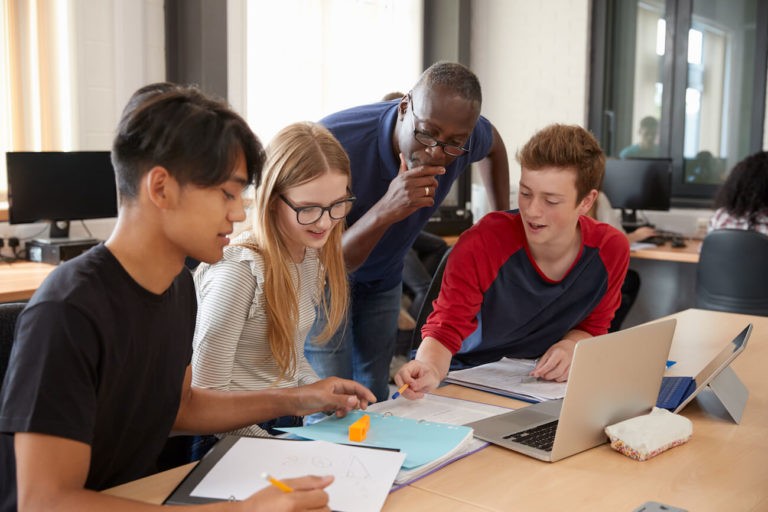The educational system as a whole is one which has experienced significant changes over the last 50 years or so. Traditional educational models have been very teacher-centered, with teachers providing direct instruction with little to no room for student engagement opportunities or empowerment in their own learning.
Over the last ten years, the traditional classroom model has changed dramatically with a shift in the model of content delivery. One of the most prominent themes in K-12 education currently is student-centered instruction, and teachers today utilize a myriad of student-centered learning strategies to equip, prepare, and produce students capable of success after graduation.
Benefits of a Student-Centered Approach to Learning
A student-centered approach varies greatly from the traditional teacher-centered instructional model. In a student-centered approach to learning, classrooms move from direct instruction to a more community-driven environment, one which supports student empowerment, conversations, critical thinking skills, independence, and problem-solving techniques. In student-centered classrooms, the change begins with the teacher. Student-centered learning strategies do require and involve students in the overall planning process, implementation, and assessments. As educators continue to refine and hone their instructional practices, here are several strategies for implementing a student-centered classroom:
Student-Centered Teaching Strategies
Choice Boards
Choice boards allow students to select activities they will complete to practice a skill or demonstrate understanding. In this approach to learning, students are given ownership and empowerment opportunities while teachers differentiate their instruction. Choice boards can be utilized not just for assessment purposes, but also to introduce new material, for supplemental practice, or as a combination of multiple parts of a lesson or unit.
Jigsaw/Stations/Centers
Although an older concept, the Jigsaw method has evolved and been combined into a center/station approach. In its most basic form, this strategy involves students utilizing cooperative learning as they seek to put the “puzzle” together. Each student takes responsibility for an individual component of knowledge, then takes knowledge learned and gained and applies it to the larger body of work (puzzle). I have seen this concept used at the elementary, middle, and high school level with teachers establishing stations and centers in their classroom to help facilitate the individual or small-group knowledge piece of the Jigsaw strategy, leading to some type of presentation, discussion, competition, or other strategy used to demonstrate learning.
Inquiry-Based Learning
In this learning strategy, student questions, ideas, and analysis are highlighted and fostered, focusing on the student perspective regarding a particular open question or problem. This strategy is particularly useful for initial student engagement, leading students to move beyond basic knowledge to a deeper understanding of critical thinking, evidence-based reasoning, and creative problem solving. Within inquiry-based learning, various components of a lesson can include case studies, group projects, and research projects, among others. More in-depth connections to the material provide opportunities for students to hone skills that are highly valuable in the world in which we now live.
Project-Based Learning and Problem-Based Learning
Teachers have their own educational jargon, and often-times, you will hear “PBL” used in teacher discussions. Two learning strategies being implemented more often are project-based learning and problem-based learning. In project-based learning, students work on longer tasks that culminate in the creation of an original presentation or product. This learning strategy depends heavily on student collaboration, communication, and creativity, with the teacher serving as a facilitator student work and progress.
Problem-based learning includes shorter projects that examine a current problem, and through definition, research, and causes of the problem, students collaboratively evaluate solutions to the chosen problem, solve the problem, or report potential solutions and/or findings. Both of these learning strategies utilize relevant, real-life connections to the outside world, providing students valuable experience with problem solving and critical thinking opportunities that will behoove them after graduation.
Flipped Classrooms
Teachers continuously seek ways to maximize instructional time within the classroom. A learning strategy that takes this into account is the use of a flipped classroom. In this learning format, new or introductory content is delivered to students outside of the classroom, with teachers incorporating many of the strategies already discussed such as choice boards or jigsawing to allow student choice in their learning. Learning material can include readings, videos, pre-recorded presentations or direct instruction, or research assignments.
In this model, classroom time is used by the teacher to facilitate learning and help students gain practice applying knowledge learned outside of the classroom. Instead of the typical “exit ticket,” in which students hand in a ticket showing mastery or further questions about understanding, students use “entrance tickets,” in which they enter the classroom with a completed assignment, written response, quiz, or blog post serving as their “ticket.” Ultimately, the flipped classroom model can incorporate multiple student-centered learning strategies, making it very popular in schools today.
The educational model of content delivery as we know it is changing. Now more than ever, student-centered approaches to learning are critical. Just as school leaders seek to build capacity in their teachers, we must seek to build capacity, leadership, critical thinking skills, and complex problem solving in our students. Student-centered learning strategies provide empowerment opportunities that allow a deep dive into more than just mandated assessments or canned, standards-based curriculum. Utilizing the strategies discussed can set you on a path to producing students ready to make a difference in an ever-changing, global society.




